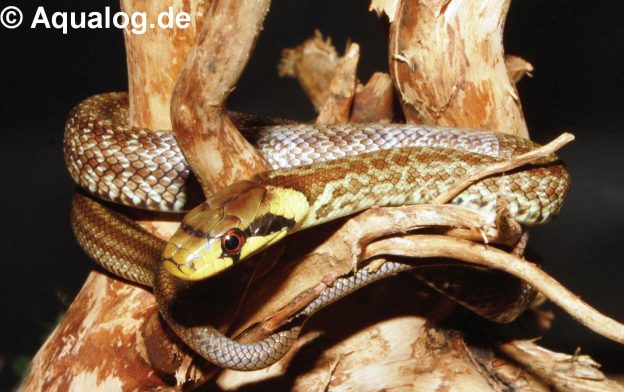
Aesculapius was the god of healing, or more accurately a demigod, as he
was fathered by the god Apollo on the mortal Coronis. Hence Aesculapius
was himself mortal and was eventually killed by Zeus, the mightiest of the
gods, because he perfected healing to such an extent that he brought a
dead person back to life, thereby arousing the anger of the gods.
Aesculapius is always portrayed as a bearded man bearing a staff, which in turn has a snake winding round it. Even today the staff of Aesculapius remains the symbol of the medical profession. Naturally it is impossible to say precisely what species the snake winding round the staff is. But there are comparatively few snake species in Europe that climb regularly. One of these is
the Aesculapian Snake, Elaphe (or Zamenis) longissima, which hence
has become linked with the god of healing. But its scientific name means nothing of the sort, but simply “the longest”. Laurenti, who gave the snake its Latin name, probably didn’t believe in the cult…

Snake or worm?
The interpretation of the staff of Aesculapius is, however, not undisputed.
Although there is no doubt that the cult of Aesculapius existed in the Mediterranean area, and it is also known for certain that snakes were kept in the temples and the peaceful, non-venomous, and slow-to-bite Aesculapian Snake was surely among them, there is also a completely different explanation for the staff. There is a horrible parasite of humans known as the Medina Worm (Dracunculus medinae). Humans can become infected if they drink unfiltered water and thus swallow the small copepods (Cyclops, etc) that are intermediate hosts. for the Medina Worm. Once swallowed, the worm larva hatches in the stomach of the human, bores through the intestinal wall, and migrates into the body cavity. Here the male, which is only 3 cm long, mates with the up to 120 cm long female and then dies. The human body encapsulates it and it poses no danger.
But the female migrates through the tissue of the afflicted person and heads for an area where the victim comes into contact with
water, where she causes a pigeon-sized “boil”. If the area comes into contact with water, the thin skin covering the top of the boil bursts and the female protrudes the end of her body and releases hundreds of larvae into the water, where they parasitize Cyclops – and the cycle is complete. The removal of the worm is possible only by fixing the end of the female’s body to a stick and carefully winding it round the latter – no more than 10 cm per day. If the worm ruptures, dangerous infection may follow.
The removal of the worm (which is virtually extinct today, but was widespread in the Mediterranean area – Egypt, for example – in historic times) was reserved for specialists. The theory that these specialists used a rod with a worm wound round it as the emblem of their profession, and that subsequently this symbol was metamorphosed into the staff and snake in Greece (where the Medina Worm didn’t occur), is at least plausible.

Aesculapian Snakes in the terrarium
This splendid, up to 2 meters long, snake is an ideal terrarium occupant, whose maintenance can also be warmly recommended to beginners. It can be fed on mice. The terrarium for Aesculapian Snakes should be tall and contain plenty of branches for climbing. The Aesculapian Snake isn’t sensitive to temperature (it occurs even in Germany) and doesn’t require a lot of warmth. A daytime temperature of 20-24°C and a heat lamp will be completely adequate, but it is essential to make sure the snake can’t wind itself round the lamp and suffer serious burns as a result.

Anzeige






